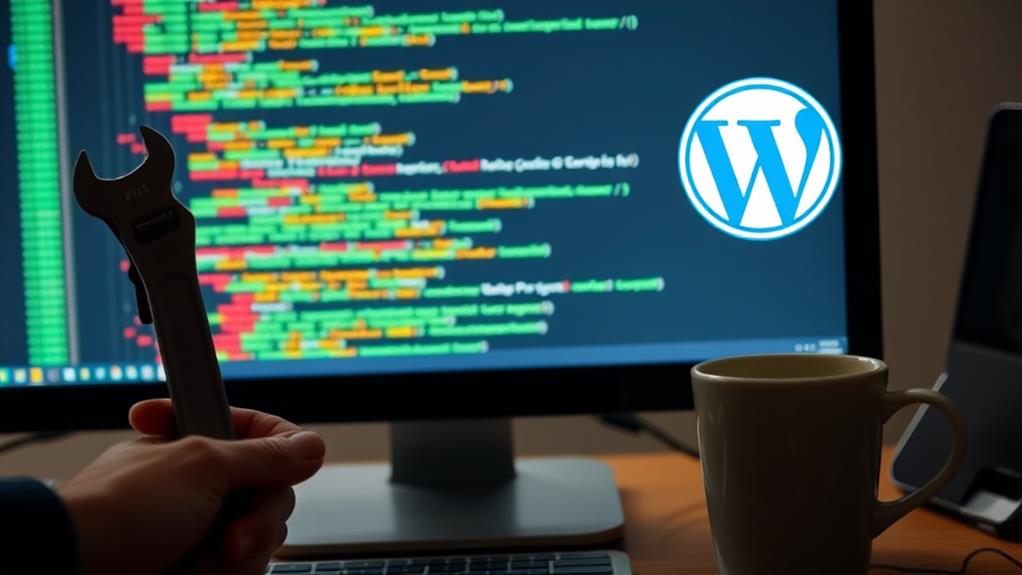If you're facing a missing MySQL extension error in your PHP installation for WordPress, start by creating a 'phpinfo.php' file to check your PHP version and loaded extensions. Verify you're using PHP 7.4 or higher, as older versions may not support necessary extensions. Install MySQLi or PDO_MySQL if they're missing, and make certain to uncomment the relevant lines in your 'php.ini' file. After making changes, restart your web server. If issues persist, reach out to your hosting provider for assistance. There's more to explore on maintaining compatibility and preventing future issues.
Understanding the MySQL Extension Error
When you encounter the MySQL extension error in WordPress, it's like hitting a brick wall on your website. This error usually means your PHP installation doesn't have the necessary MySQL or MySQLi extension needed for WordPress to connect to its database.
It often crops up when you're running PHP 7 or higher with an outdated version of WordPress—specifically, versions below 3.9. That's because the MySQL extension has been deprecated in favor of MySQLi and PDO_MySQL. Ensuring you're using PHP 7.4 or higher is essential for compatibility with WordPress, as it enhances both speed and error handling.
To understand the issue better, you can create a phpinfo.php file on your server. This file will help you check your PHP version and see if the MySQL or MySQLi extension is loaded.
If you find that the MySQL extension is missing, it typically requires installation through your server's package manager. If you're unsure how to do this, contacting your hosting provider can be a quick way to get help.
Regularly updating your PHP, WordPress, and plugins is vital to avoid these compatibility issues, including the MySQL extension error, ensuring your site stays secure and functional.
Causes of the MySQL Extension Error
The MySQL extension error often arises from a few key issues that can disrupt your WordPress site's functionality. One common cause is your PHP installation lacking the necessary MySQL extension, which is vital for WordPress to communicate with its database.
A proper database setup is fundamental for seamless operation, and if you're using outdated WordPress versions, this could also lead to incompatibility with newer PHP versions, especially PHP 7 and above, where the MySQL extension has been deprecated in favor of MySQLi and PDO_MySQL.
Another factor could be a misconfiguration in your php.ini file. If the MySQL extension isn't properly loaded, you'll encounter the MySQL extension error. You can verify this by checking the phpinfo.php file to see if the MySQL or mysqli section is present.
Lastly, if your hosting environment doesn't support the required MySQL extension, this error may pop up. In such cases, reach out to your hosting provider to confirm they've the necessary installations or upgrades available.
Diagnosing the PHP Version

To diagnose your PHP version, you can create a simple phpinfo.php file in your root directory and access it through your browser.
This will show you the PHP version at the top of the page, helping you verify it meets WordPress's compatibility requirements.
It's crucial to mention that the recommended PHP version for ideal performance is 7.4 or higher.
Checking this regularly can prevent issues with plugins or themes that depend on specific PHP features.
Checking PHP Installation Details
Diagnosing your PHP version and installation details is essential for ensuring your WordPress site runs smoothly.
To check your PHP installation, create a file named 'phpinfo.php' in the root directory of your WordPress site. Add the following code to the file:
'''php
'''
Then, access this file through your web browser. This will display a wealth of information about your PHP installation, including the version number, loaded extensions, and configuration file paths.
Pay attention to the following:
- The PHP version should be 5.6 or higher for ideal performance and security.
- Look for the "Client API library version" to verify if the MySQL extension is installed and functioning correctly.
If you find the MySQL extension is missing or your PHP version is outdated, consider reaching out to your hosting provider for help.
Verifying PHP Compatibility Requirements
Verifying your PHP version meets the compatibility requirements is vital for a smooth-running WordPress site. WordPress has deprecated the MySQL extension starting with PHP 7.0, so you need to have at least PHP 7.4 for peak performance and security.
To check your current PHP version, simply create a file named phpinfo.php with the code '' and open it in your web browser. This will display detailed information about your PHP setup.
If your PHP version is below 5.6, you might lack support for the MySQLi extension, which is essential for modern database interactions in WordPress. Running an outdated PHP version can lead to compatibility issues, especially with the MySQL extension.
WordPress recommends using the latest stable version of PHP to guarantee you meet all WordPress requirements and to prevent potential security vulnerabilities.
Regularly verifying and updating your PHP version can be done through your hosting control panel. If you're unsure, consult with your hosting provider to make certain that your site runs smoothly and securely with the latest PHP enhancements.
Don't overlook this important step in maintaining your WordPress site!
Updating WordPress Software
Before you update your WordPress software, you need to back up your entire site to avoid any data loss.
Regular backups are essential for maintaining user experience and security, especially given that 50 small to medium-sized businesses face breaches daily (daily WordPress backups).
Once that's done, download the latest version from WordPress.org and replace the old files in the wp-includes and wp-admin directories.
This process will help guarantee your site runs smoothly and the MySQL extension error gets fixed.
Backup Your Site First
Creating a complete backup of your site is vital before updating WordPress. This precaution helps prevent data loss in case anything goes wrong during the update process. A reliable backup guarantees you can restore your site quickly and easily.
Here are some key tips for effective backups:
- Use plugins like UpdraftPlus or BackupBuddy for straightforward backup solutions.
- Store backups in multiple locations, like Google Drive, Dropbox, and your local machine.
- Familiarize yourself with your hosting provider's backup options for added safety.
Regularly scheduling backups, especially before major updates or changes, is essential to maintain a reliable recovery point.
It's important to back up not only your WordPress files but also your database. This guarantees that all your content and settings are preserved.
If you're concerned about your PHP installation or the missing MySQL extension, having a backup allows you to experiment with fixes without fear of losing your data.
Download Latest Version
To keep your WordPress site running smoothly, it's crucial to download the latest version of the software from WordPress.org. This guarantees you have the necessary updates to maintain compatibility with modern PHP versions, especially if you're facing issues like the Missing MySQL Extension.
Before you begin, make certain you've backed up your site to prevent any data loss during the update process. Once you're ready, go ahead and download the latest version of WordPress.
Before uploading the new files via FTP, delete the wp-config-sample.php, wp-config.php, and wp-content folder from your server. This helps avoid conflicts with your existing installation.
Using an FTP client, you'll now upload the newly downloaded version. Be careful to keep your wp-content folder intact to preserve all your themes and plugins.
After the upload, check back on your WordPress site to verify the successful installation. Look for any update notifications in the dashboard to confirm everything is running smoothly.
Overwrite Old Files
Updating your WordPress software involves overwriting old files, which is fundamental for resolving issues like the Missing MySQL Extension. By confirming the MySQL extension is installed and updating your PHP, you can maintain a smooth-running site. Here's how to proceed:
- Back up your entire site to prevent data loss.
- Download and extract the latest WordPress version from WordPress.org.
- Connect to your server using an FTP client.
Start by directing yourself to the root directory of your WordPress installation. Delete the old 'wp-includes' and 'wp-admin' directories. This step is vital as it guarantees that you're replacing outdated files with the latest ones.
Next, upload the new 'wp-includes' and 'wp-admin' directories from the extracted files, but be careful not to overwrite the 'wp-content' folder or the 'wp-config.php' file. These contain your custom settings and uploads.
Once you've completed the upload, check your site to confirm the update was successful. Verify all functionalities, including your database connections, are intact.
This process not only updates your WordPress version but also helps maintain compatibility with the latest PHP settings.
Checking MySQL Extension Installation

Checking the installation of the MySQL extension is essential for guaranteeing your WordPress site runs smoothly. To check whether the MySQL extension is installed or enabled in your PHP environment, create a 'phpinfo.php' file with the code ''.
Access this file via your web browser to view your PHP configuration. Look for the "Client API library version" section; if it's missing, the MySQL extension isn't installed or enabled. Additionally, it's a good practice to regularly back up the database to prevent data loss and guarantee recovery.
For PHP versions 5.6 or lower, confirm that the MySQL extension appears as either "mysql" or "mysqli." If you don't see these entries, you'll need to install the extension.
Alternatively, you can verify the MySQL extension from the command line. Run the command 'php -m' to list all loaded PHP modules and check for "mysql" or "mysqli" in the output.
Remember that after making any changes related to the MySQL extension installation or configuration, you'll need to restart your web server to apply the changes effectively. This step guarantees that your WordPress site can properly connect to the database and function as expected.
Configuring PHP for MySQL
Properly configuring PHP for MySQL is essential for guaranteeing your WordPress site operates efficiently. To get started, follow these key steps:
- Make sure you've installed the necessary MySQL extension, like MySQLi or PDO_MySQL. Additionally, guarantee that your hosting provider offers reliable hosting options to support your PHP configuration needs.
- Check your php.ini file for the correct extension loading syntax.
- Restart your web server after making changes.
First, verify that you're using PHP 7 or later, as earlier versions support the deprecated MySQL extension. Open your php.ini file and look for lines like 'extension=mysqli.so' or 'extension=pdo_mysql.so'. Guarantee these lines are uncommented to enable the desired MySQL extensions.
After modifying the php.ini file, don't forget to restart your web server, whether it's Apache or Nginx, to apply your changes.
Lastly, use the 'phpinfo()' function to confirm that the MySQL extensions are loaded correctly. Check the output for sections labeled "mysqli" or "PDO" to verify their presence.
If you're on shared hosting, you might've a user-friendly interface like cPanel that lets you enable MySQL extensions without manual file edits. This approach simplifies the process of configuring PHP for MySQL, guaranteeing your WordPress site runs smoothly.
Manual Plugin Update Methods

If you prefer a more hands-on approach, the SFTP Method allows you to connect to your server using an FTP client like FileZilla.
It's crucial to back up your site using reliable WordPress backup plugins to prevent data loss during this process. Navigate to the /wp-content/plugins/ directory, download the latest plugin version, delete the existing folder, and upload the new one.
For those with WP-CLI installed, you can take advantage of the command line. Open the terminal, navigate to your WordPress root directory, and execute the command 'wp plugin update plugin-name' to streamline the process.
Before you proceed with any manual plugin update, make certain to back up your site to prevent data loss.
Also, confirm that the new plugin version is compatible with your current WordPress version, especially if your PHP installation appears outdated and requires you to update the PHP version.
Troubleshooting Missing MySQL Extension
One common issue you might encounter when running WordPress is the missing MySQL extension error, especially if you're using PHP 7 or higher with an outdated version of WordPress.
PHP has deprecated the MySQL extension in favor of MySQLi and PDO_MySQL, so you'll need to troubleshoot this. To enhance your website's security and reduce the risk of vulnerabilities, it's important to keep your themes and plugins updated regularly, as outdated software can lead to complications, including compatibility issues with PHP extensions common entry points for cyber threats.
Here are a few steps to help you out:
- Check your PHP version: Create a 'phpinfo.php' file to review your PHP settings.
- Install the necessary extension: Use your server's package manager to install the MySQL extension.
- Edit your php.ini file: Uncomment the line for the MySQL extension and restart your web server.
If you're still missing the MySQL extension after these steps, confirm your PHP Extension Is Configured properly.
Sometimes you might need to contact your hosting provider for assistance. They can help you install or configure the MySQL extension if you're unable to do it yourself.
Preventing Future Errors

To prevent future errors related to the MySQL extension, it's crucial to adopt proactive measures that keep your WordPress environment stable and secure.
Regularly update your WordPress installation, themes, and plugins to guarantee compatibility with the latest PHP versions, as outdated plugins are a major cause of vulnerabilities. This minimizes the risk of MySQL extension errors, especially as older versions become unsupported.
Additionally, consider implementing strong security practices, such as using security plugins like Wordfence and Sucuri, to further safeguard your site against threats common vulnerabilities.
Keep an eye on your PHP version and upgrade to supported versions like PHP 7.4 or higher. This helps reduce the likelihood of encountering MySQL-related issues.
Additionally, schedule routine backups of your WordPress site to safeguard against potential data loss. These backups allow for quick recovery in case of configuration errors or extension issues.
Don't forget to consult your hosting provider's documentation or support for best practices regarding PHP and MySQL management. This guarantees your server settings are optimized and compliant with the latest requirements.
Finally, utilize tools like WP-CLI or dashboard notifications to stay informed about necessary updates and any compatibility issues that might arise from outdated software components.
Conclusion
Fixing the missing MySQL extension can feel like searching for a lost key in a dark room. You know it's there, but it takes a bit of effort to find it. By understanding the causes and following the steps outlined, you'll access your WordPress site's full potential. Just like finding that key brings light back into the room, resolving this issue will breathe new life into your website, allowing it to thrive and flourish once again.



